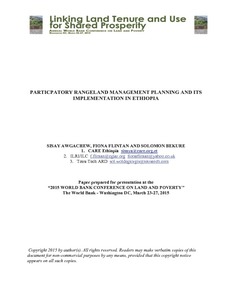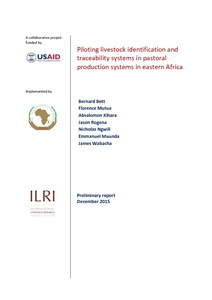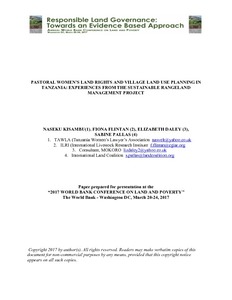Participatory rangeland management planning and its implementation in Ethiopia
The pastoral and agro-pastoral areas of Ethiopia cover around 65% of the country’s surface area. Rangeland resources are managed under collective common property arrangements, which are increasingly coming under pressure from both internal and external forces of change including alternative, but not necessarily ‘appropriate’, land uses.
Our land, our animals: Herding in Kenya's Kitengela rangelands
Nickson Parmisa, a resident of Kitengela just outside Nairobi in Kenya, talks about the challenges of livestock herding in the face of climate change.
Participatory analysis of vulnerability to drought in three agro-pastoral communities in the West African Sahel
Drought is one of the major climatic hazards impacting on the various sectors including crop and livestock in the West African Sahel. Pastoral and agro-pastoral communities in the region are regularly affected by drought, with vulnerability differing with gender, age, wealth status (access to cropland and livestock endowment), geographic location, social networks, and previous exposure to drought. Effective interventions require regular monitoring of vulnerability to drought, for which various quantitative and qualitative approaches exist.
Pastoralism: Animal health and food safety situation analysis, Kenya and Tanzania
Pastoralism is a farming system in societies that derive majority of their food and
income from livestock production. This form of farming system is practised in the
world’s arid and semi arid lands (ASALs). It is estimated that 70% of the landmass
in the Horn of Africa is dry land; in Kenya 80% of the landmass is classified as ASAL
while approximately half of Tanzania consists of dry land. These dry lands can only
be effectively utilised when used for livestock rearing, supporting wildlife resource
harvesting and tourism.
Piloting livestock identification and traceability systems in pastoral production systems in eastern Africa
Pastoral women’s land rights and village land use planning in Tanzania: Experiences from the sustainable rangeland management project
In pastoral societies women face many challenges. Some describe these as a ‘double burden’ – that is, as pastoralists and as women. However, pastoral women may obtain a significant degree of protection from customary law even if customary institutions are male-dominated. In periods of change (economic, social, political), this protection may be lost, and without protection from statutory laws, women are in danger of “falling between two stools” (Adoko and Levine 2009).
Pastoralists preferences for cattle traits: Letting them be heard
This paper investigates preferences for cattle traits among a pastoral community in a trypanosomosis prevalent area in Kenya. Choice experiments and mixed logit models are employed to estimate economic values of preferred traits which could be introduced through systematic breeding in breed improvement programs that utilise trypanotolerance trait. The findings suggest preference for traits linked to drought tolerance, high live weight, trypanotolerance and fecundity.
Pastoral issues must be part of ILRI’s research agenda into the future
Ian Scoones, Science Adviser to ILRI reflects on the recent conference on the future of pastoralism and the work of ILRI in this area. He argues that pastoralism ‘must be part of ILRI’s research agenda into the future.” He identifies two promising areas: First, to engage in technical research on production issues in pastoral areas and pastoral systems - to sustain the enormous economic potential of such areas. Second, to support the broader area of innovation.
Pastoralism 'alive and well' in Africa
Ian Scoones from the Institute of Development Studies and the Future Agricultures Consortium reflects on some key issues emerging from a recent conference on the future of pastoralism in Africa. His overwhelming conclusion: Pastoralism is "alive and well" in some parts of the continent. But there are downsides: constraints caused by pressures on land, as well as recurring conflicts. This leads to a division between those who are "really making it" and those who are "really struggling." This poses major policy issues at the two ends of these extremes.








